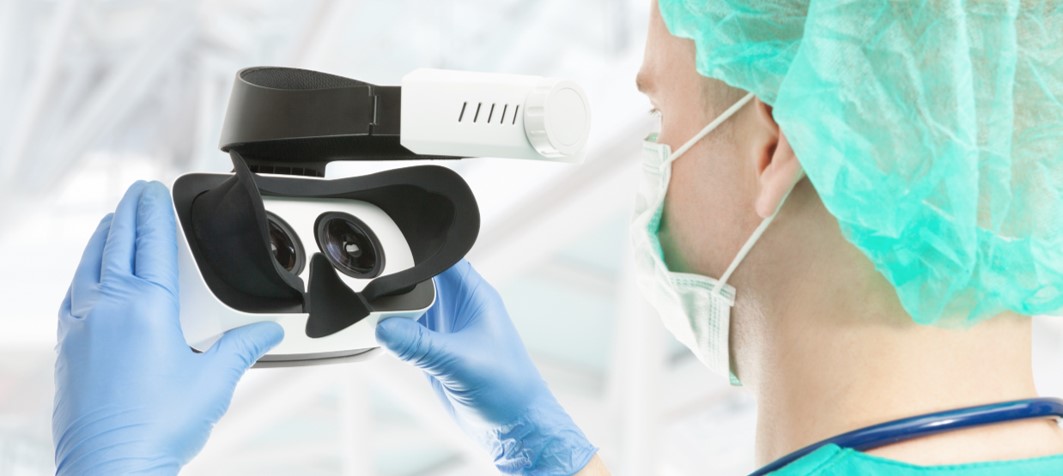What does fighter jet flight simulation have to do with neurosurgery?
The answer is simple: Surgical Theater – a Cleveland-based startup that uses flight simulator technology for brain surgery – co-founded by former Israeli Air Force officers Moty Avisar and Alon Geri.

And while brain surgery with a game pad is probably the most mind-blowing of the healthcare-related applications of VR, there are many other innovative medical tools and platforms that have been developed recently based on the technology. In clinical settings, VR is being integrated in physical therapy programs, in the treatment of mental health disorders, and for medical training and education, as well as in a wide range of consumer and outpatient applications.
VR for the OR: 360 Degree, Interactive Medical Imaging

Designed for two gaming headsets – the HTC Vive and the Oculus Rift – and addressing what is estimated to be $4.5B global market opportunity, Surgical Theater increases the success rates of brain surgery by allowing surgeons to actually see from the inside how every nerve and blood vessel feed into and through a tumor. It also gives them a fuller understanding of the proximity of the tumor to critical motor and speech areas, which must be avoided during surgery.

Avisar likes to illustrate how this works with an anecdote about a 5-year-old boy with a brain tumor who was treated at Stanford last summer. He arrived at the doctor’s office looking sad and disengaged – but once the surgeon gave him a VR headset and showed him what his brain looked like, and helped him see his tumor, his experience was transformed. This little boy was actually able to “fly” his parents through a VR reconstruction of his own tumor, and suddenly became interested in working with the physician in developing a plan for his surgery.
Surgical Theater’s platform for pre-operative planning is the first of its products, but there are others in development. For example, the company is collaborating with Brainlab, an image-guided surgery system that tracks where a patient is during surgery. The goal is to integrate Surgical Theater’s platform with Brainlab’s navigation system, allowing surgeons to track a patient live, during surgery – on the dynamic, patient-specific 3D model used during rehearsal.
VR for PT: Gesture-Driven Interactive Technologies
VR systems and gesture-driven interactive technology for therapy and rehabilitation are becoming increasingly popular, yielding studies with results that demonstrate a link between the effectiveness that these two together can provide. The combination has been proven effective in rehabilitating individuals who suffered from strokes, surgeries, and injuries.

Using a solution called the Computer Assisted Rehabilitation Environment, Dr. Kalika created an immersive environment that facilitates the learning of movement strategies and supports the “unlearning” of counterproductive movements. The company’s gesture-controlled solutions for result in marked improvement of physical conditions regardless of age, ability, or stage of recovery.
Virtual reality (VR) technology has the capability of creating an interactive, motivating environment in which practice intensity and feedback can be manipulated to create individualized treatments to retrain movement.”
– taken from Virtual Reality – Augmented Rehabilitation for Patients Following Stroke in the Journal of the American Physical Therapy Association

Gesturetekhealth offers touch-free, gesture-controlled solutions for VR therapy, multisensory simulation, and immersive play, creating therapeutic experiences that lead to marked improvements of physical and cognitive conditions.
VR for Mental Health: Simulating Anxiety-Inducing Stimuli
While a limited number of therapists have been using VR since the early 1990s, it wasn’t widely adopted because of its prohibitive costs and the limitations of the technology.
Until now. With the development and commercialization of affordable, mobile VR headsets, there is a growing opportunity to use this technique for anxiety disorders, panic disorder, phobias, post-traumatic stress disorder (PTSD), and obsessive-compulsive disorder (OCD).

A key component of CBT is exposure, i.e. introducing clients to controlled amounts of the thing they feared. VR is a powerful tool in this context, because it can simulate the anxiety-inducing stimuli in a safe environment.
One company creating VR applications for mental health disorders and phobias is Virtually Better, whose tool Bravemind helps clinicians expose patients gradually to stimuli that trigger traumatic stress responses.
VR for Burn Victims: Offering Pain Relief
Another compelling use of VR is in the area of pain reduction. SnowWorld, first developed around fifteen years ago by Hunter Hoffman, is designed to distract burn victims from the terrible pain associated with their treatments – by virtually transporting them through an icy canyon filled with snowball-hurling snowmen and other distractions.
The developers of SnowWorld recently launched DeepStream VR, where they continue to develop new VR tools with healthcare applications.
VR for the Consumer Market

A number of VR apps are available in this sector including Runtastic, which helps you with your workout by immersing you in virtual environs designed to inspire, and Icaros, a fitness gaming device that encourages you to work harder by simulating flying.

A Hot Industry for Investment
Health-related VR solutions are addressing a rapidly growing, multibillion-dollar market that is poised for disruption. In many cases, the new technologies represent a drastic improvement over existing methodologies, which are outdated and limited.

The market is ready for it: Many hospitals are now investing in new technologies in order to improve surgical outcome, and these innovations range from better imaging tools to navigation systems to robotic surgery platforms and can cost anywhere from $150,000 to over $1M. There are over 5,000 surgery centers in the U.S. with a combined total of over 40,000 operating rooms. At $250,000 per Surgery Rehearsal Platform, this represents over a $1.25B total addressable market in the U.S. alone.
The company is gaining traction, with a customer base that already includes prestigious medical centers such as The Mayo Clinic, Mount Sinai Health System, Stanford University, and UCLA. Surgical Theater estimates that its solution has been used in over 1,800 procedures, further establishing its reputation as a leader in the space.
The Financial Power of a Virtual Cure
Existing research on the use of VR and simulation has demonstrated that surgeons make 6 times fewer errors, reduce time in the OR by 30%, and receive reductions in malpractice insurance premiums when using these technologies.
In addition to these many advantages, the SRP solution has the potential to boost a hospital’s revenue, because simulation-based rehearsal can generally be reimbursed at a higher insurance code. Furthermore, the SRP could be used for simulation-based consultations and could be billed at the highest level. And in the near term, until the SRP will be diffuse, it also serves a good patient recruiting and marketing tool.
READ MORE: Reality check! Mapping the Israeli VR and AR startup landscape [Infographic]
Putting aside the specific case of Surgical Theater, the potential market for VR in therapeutic settings is huge – with mental health disorders and psychological conditions, for example, estimated to cost a whopping $467B in lost productivity and medical expenses in the U.S. alone. Many doctors tend to over-prescribe medications that have side effects or are simply unnecessary, and VR is a potential game-changer because it can provide successful treatment for certain disorders without the use of medication.
And that’s just the beginning. The feeling is that VR tech, in general, is still at the beginning of its journey. A recent PC World article, for example, discussed the launch of a new Allwinner H3VR chipset, which frees VR headsets from being attached to smartphones or VCs and is further driving down VR headset prices. Though further technological developments are necessary to put the lower-cost headsets on par with the viewing quality and technical capabilities of the Oculus Rift and HTC Vive, the technology is moving fast.
As VR headset prices continue drop and the technology becomes more affordable and accessible, VR-based tools and platforms for medical procedures and treatments are expected to become increasingly widespread – opening opportunities for new therapeutic paths in a wide range of medical situations and offering treatment alternatives that are drug-free.
To find out more about VR technologies and investment opportunities on our platform, contact our Investor Relations team or visit our website.








